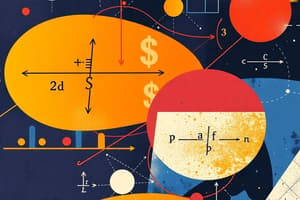Podcast
Questions and Answers
Which of the following accurately defines a cost object?
Which of the following accurately defines a cost object?
- Anything for which a cost is determined or analyzed. (correct)
- A method used to allocate indirect costs to cost objects.
- The total of all costs incurred in the production process.
- A fixed cost that does not change with activity levels.
What best describes a cost function?
What best describes a cost function?
- A mathematical model showing how costs change with activity levels. (correct)
- The total fixed and variable costs incurred for a specific period.
- An analysis comparing direct and indirect costs.
- A graphical representation of cost trends over time.
Which statement correctly characterizes indirect costs?
Which statement correctly characterizes indirect costs?
- They are always related to direct labor and material costs.
- They can be easily traced to specific cost objects easily.
- They are typically low in percentage compared to direct costs.
- They require systematic allocation to cost objects due to tracing difficulties. (correct)
Which of the following is an example of a direct cost?
Which of the following is an example of a direct cost?
How are variable costs defined in relation to production?
How are variable costs defined in relation to production?
What happens to fixed cost per unit as production volume increases?
What happens to fixed cost per unit as production volume increases?
Which of the following correctly defines relevant costs?
Which of the following correctly defines relevant costs?
What primarily defines operating leverage in a business?
What primarily defines operating leverage in a business?
In Activity-Based Costing, what is the primary factor determining cost allocation?
In Activity-Based Costing, what is the primary factor determining cost allocation?
What is the purpose of sensitivity analysis in Cost-Volume-Profit analysis?
What is the purpose of sensitivity analysis in Cost-Volume-Profit analysis?
Flashcards are hidden until you start studying
Study Notes
Cost Concepts
- Cost Object: Any entity for which costs are measured, such as a specific product.
- Cost Function: Mathematical model illustrating the relationship between cost and activity level.
- Cost Assignment: Process of tracking accumulated costs to a specific cost object.
Cost Tracing and Allocation
- Tracing: Identifies direct costs linked to a cost object, like materials and labor for a water bottle.
- Allocating: Distributes indirect costs that cannot be directly traced to a cost object, such as factory maintenance expenses.
Types of Costs
- Direct Costs: Easily traced to a cost object, such as the materials for a vehicle.
- Indirect Costs: Cannot be directly traced; typically allocated to cost objects, like overall factory overhead.
Cost Classifications
- Overhead Costs: Indirect costs not directly tied to production.
- Variable Costs: Change with the level of production; more units increase total costs.
- Fixed Costs: Do not change with production volume; costs like rent remain constant unless renegotiated.
Cost Per Unit Dynamics
- Variable Cost Per Unit: Remains constant regardless of quantity produced; total cost varies with volume.
- Fixed Cost Per Unit: Decreases as production increases; total fixed costs spread over more units.
Cost Structure
- Cost Driver: Variable impacting total cost based on activity level, e.g., km driven affects petrol cost.
- Relevant Range: Activity level where specific cost relationships hold true, applicable to fixed costs.
Product Costs
- Conversion Costs: Expenses associated with transforming raw materials into finished goods.
- Prime Cost: Total direct costs, combining materials and labor.
- Inventoriable Costs: Costs tied to inventory, treated as assets until sold.
Inventory Types
- Manufacturing Inventory: Direct materials ready for use.
- Work-in-process: Products partially completed.
- Finished Goods: Products ready for sale.
Costing Methods
- Job Costing: Tracks costs individually for unique items or projects.
- Process Costing: Applies to mass production of similar items through standardized processes.
Financial Analysis Tools
- CVP Analysis: Examines profit impact from changes in sales volume, price, or cost.
- Assumptions include linear cost behavior and constant cost structure.
Margin of Safety
- Indicates the difference between actual sales and breakeven sales, providing insight into risk.
Sensitivity Analysis
- Evaluates how variations in key inputs impact profitability within CVP analysis.
Costing Approaches
- Weighted Average Process-Costing: Determines cost per equivalent unit, accounting for both completed and in-process items.
- Operating Leverage: Measures the sensitivity of profit to changes in sales volume, influenced by the ratio of fixed to variable costs.
Decision-Making Considerations
- Relevant Information: Future-oriented differences among alternatives; includes expected costs and revenues.
- Irrelevant Information: Historical costs that do not affect current decision-making.
Incremental Measures
- Incremental Revenue and Costs: Focus on additional revenue and costs tied to specific activities.
- Differential Revenue and Costs: Differences in revenue/cost between alternatives assist in evaluating options.
Cost Allocation Issues
- Over costing: Low resource-consuming products receive exaggerated cost allocations.
- Under costing: High resource-consuming products receive insufficient cost allocations.
Costing Techniques
- Peanut Butter Costing: Uses broad averages to allocate costs uniformly across products.
- Activity-Based Costing (ABC): Allocates costs based on actual resource utilization by activities, enhancing cost accuracy and providing relevant insights.
Value Chain Components
- Research & Development: Focused on innovation and product enhancement.
- Design: Involves planning product design and manufacturing processes.
- Production: Covers labor and materials in the creation of products.
- Marketing: Focus on consumer preferences and targeted promotional strategies.
- Distribution: Expenses related to delivering products to customers.
- Customer Service: Managing customer inquiries post-sale.
Studying That Suits You
Use AI to generate personalized quizzes and flashcards to suit your learning preferences.




